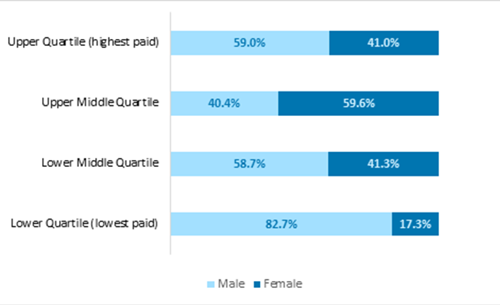Gender pay gap report
Last Updated: 3 April 2024
As an employer of over 250 people we are required by law to carry out gender pay reporting under the Equality Act 2010 (Gender Pay Gap Information) Regulations 2017.
The gender pay gap is different to equal pay which is the legal requirement that men and women are paid equally for doing the same job under the Equality Act 2010.
Gender pay reporting involves carrying out calculations that show the difference between the average earnings of men and women in our organisation. It will not involve publishing individual employee's data.
We are required to publish the results on our own website and a government website every year by the 30 March for the previous year's data.
How we calculate gender pay gap
There are six basic calculations. The calculations are:
- our mean gender pay gap
- our median gender pay gap
- our mean bonus gender pay gap
- our median bonus gender pay gap
- our proportion of males and females receiving a bonus payment
- our proportion of males and females in each quartile band
Note: We do not pay bonuses so calculations 3, 4 and 5 are not relevant.
We can use these results to assess:
- the levels of gender equality in our workplace
- the balance of male and female employees at different levels
- how effectively talent is being maximised and rewarded
Gender pay gap report 2023 to 2024
This data has been taken from 31 March 2023.
Women’s mean hourly rate is 2.5% higher than men’s. When comparing mean hourly rates, women earn £1.02 for every £1 that men earn.
Proportion of women in each pay quartile
This chart shows the gender split when we order hourly rate of pay from highest to lowest and group into four equal pay quartiles.

Why we have a gender pay gap
The main reason for our organisation-wide gender pay gap is an imbalance of male and female colleagues across the organisation. The mean and median pay gap figures show that overall male employees have lower pay than female. However when the gender distribution is looked at by pay quartiles a more detailed picture is revealed which shows that, at the moment, there are fewer women in senior roles than men, and a higher proportion of men relative to women in the lower scales.
How we are addressing the gender pay gap
The challenge in our organisation, and across Great Britain, is to eliminate any gender pay gap. We have the current Human Resources and company policies in place to address gender inequality:
- recruitment policy: promotion of equal opportunities and diversity, employees recruited and promoted on the basis of ability and other objective criteria, external job advertising where possible, gender balance reflected in interview panel members (ie comprised of males and females).
- maternity support leave and paternity leave available for fathers/partners
- parental leave
- shared parental leave
- special leave
- flexible working and flexi time scheme
- training in recruitment and other Human Resources practices to encourage equality and diversity for managers
- fair, equal and transparent pay and reward system: all jobs are subject to job evaluation using a job evaluation scheme that has been tested for ensuring equality
- training programme for all employees that promotes equality and diversity
- equality and diversity policy that is part of employees induction
- more training courses planned on equality and diversity topics which will be open to all
Gender pay reporting requires our organisation to make calculations based on employee gender. We will establish this by using our existing Human Resources and payroll records.
All employees can confirm and update their records if they choose to by updating their details on the internal system or by contacting Human Resources